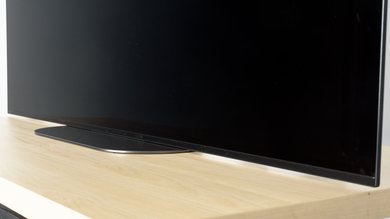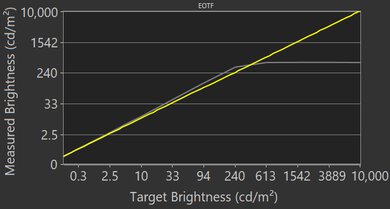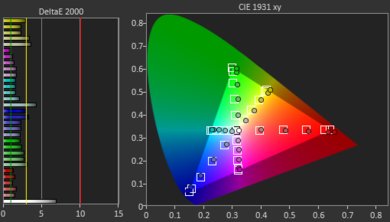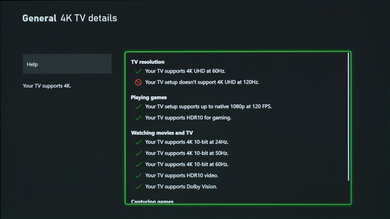Our Verdict
The Sony A9G is an excellent TV for most uses, whether it's for watching HDR movies or for use as a PC monitor. It has remarkable dark room performance and its exceptional motion handling results in clear images with nearly no visible motion blur. Its low input lag and 120Hz refresh rate provide a responsive gaming experience, but unfortunately, it doesn't support any VRR technology. It runs on Android TV, which is a great platform for those who get most of their content through streaming.
- Almost-instantaneous response time.
- Remarkable dark room performance.
- Excellent wide viewing angles.
- Brightness is limited in white scenes.
- Possibility of permanent burn-in with static content (see here).
The Sony A9G is an exceptional TV for watching movies. With its emissive technology, this TV can produce perfect blacks, which is great for watching in a dark room. It can remove judder from any source and has a motion interpolation feature to make motion look smooth and fluid.
This is a great TV for watching TV shows. It isn't the best choice for watching in very bright rooms, but in an average-lit or dark room, it performs remarkably well. Its wide viewing angles allow you to walk around without the image degrading and it upscales lower-resolution content like cable TV without any issues.
The Sony A9G is an excellent TV for watching sports. Its response time is extremely fast and fast-action sports are displayed with minimal motion blur. Gray uniformity is excellent, with no noticeable dirty screen effect, and it has wide viewing angles, making it a great TV for watching a big game with friends and family.
The Sony A9G is an outstanding TV for playing video games thanks to its extremely fast response time and low input lag. It has a 120Hz refresh rate to make motion look silky smooth, but sadly, there's no support for FreeSync variable refresh rate technology to reduce screen tearing. Also, there are risks of permanent burn-in with OLED TVs, especially with static content like the user interface of a video game.
The Sony A9G is a remarkable TV for watching HDR movies. It can produce vivid and vibrant colors thanks to its wide color gamut, and it can get decently bright to bring out small highlights in dark scenes. Since OLED TVs can turn off individual pixels, there aren't any issues with blooming around bright objects. Additionally, this TV supports HDR10 and Dolby Vision.
The Sony A9G is an excellent TV for playing HDR games. The TV can display HDR content with vibrant colors due to its wide color gamut, but its peak brightness in HDR mode is only decent and doesn't feel as dramatic, especially when using the TV in a bright room setting. On the upside, it has a low input lag in HDR mode to make gaming feel extremely responsive and its fast response time results in clear images with minimal motion blur.
The Sony A9G is a great TV for use as a PC monitor. It can display most common resolutions with proper chroma 4:4:4 without any issues, and it has excellent wide viewing angles, so the sides look uniform when you sit up close. Input lag is very low to provide incredible responsiveness, but unfortunately, a static desktop interface increases the risk of permanent burn-in.
Changelog
- Updated May 06, 2022: We changed the subtype from WRGB to WOLED as it's more accurate and more consistent with other TVs.
- Updated Apr 04, 2022: We retested the peak brightness with the latest firmware, PKG6.5066.0634NAA, but there's no change.
- Updated Jul 28, 2021: Added the real content local dimming videos.
- Updated Mar 01, 2021: Converted to Test Bench 1.6.
Check Price
Differences Between Sizes And Variants
We tested the 55" Sony MASTER Series A9G (XBR55A9G), and for the most part, we expect our review to be valid for the 65" model (XBR65A9G) and the 77" model (XBR77A9G) as well.
The European variant of the TV is also known as the AG9, and we expect it to offer the same performance.
If someone comes across a different type of panel or if their Sony A9G doesn't correspond to our review, let us know and we'll update the review. Note that some tests, such as gray uniformity, may vary between individual units.
| Size | US Model | Alternative Name | EU Model |
| 55" | XBR55A9G | XBR-55A9G | KD-55AG9 |
| 65" | XBR65A9G | XBR-65A9G | KD-65AG9 |
| 77" | XBR77A9G | XBR-77A9G | KD-77AG9 |
The Sony A9G we reviewed was manufactured in April 2019.
Popular TV Comparisons

The Sony A9G is an excellent OLED TV, but it faces steep competition from LG and Samsung in the top-end TV market. For other options, check out our recommendations for the best televisions and the best OLED TVs.
The Sony A80J OLED and the Sony A9G OLED are excellent TVs capable of completely turning off individual pixels to produce perfect blacks. That said, the A80J is a newer model with improved features and performance, particularly when it comes to peak brightness, as well as having a different processor. The A80J also has two HDMI 2.1 ports, less input lag, and has VRR support.
The Sony A9S OLED and the Sony A9G OLED are almost identical. The most notable change is the A9S' significantly lower input lag. The A9S also has better accuracy out of the box, and its Black Frame Insertion feature can flicker at 120Hz for 120fps content. The A9G has slightly better viewing angles, and its Automatic Brightness Limiter isn't as aggressive, so the overall brightness is more consistent.
The Sony A90J OLED and the Sony A9G OLED are both excellent OLED TVs. They can both turn off pixels individually to produce an infinite contrast ratio and perfect black levels, which is great for watching movies and other content. If you're a gamer, though, the A90J has a bit of an edge because it supports HDMI 2.1 and has a bit less input lag. It also gets a bit brighter in HDR if you watch a lot of HDR content.
Overall, the Sony A8H OLED is slightly better than the Sony A9G OLED. They both perform very similarly, but the A8H can get a lot brighter, it has better out-of-the-box color accuracy, and its input lag is much lower. However, if you use your TV as a PC monitor and you need native support for a 1440p resolution, then you're better off with the A9G.

We buy and test dozens of TVs yearly, taking an objective, data-driven approach to deliver results you can trust. Our testing process is complex, with hundreds of individual tests that take over a week to complete. Most of our tests are done with specially designed test patterns that mimic real content, but we also use the same sources you have at home to ensure our results match the real-world experience. We use two main tools for our testing: a Colorimetry Research CR-100 colorimeter and a CR-250 spectroradiometer.
Test Results

The Sony A9G's design is outstanding. It has a clean and minimalist look, with thin bezels on all sides, and the flat stand doesn't take up a lot of space. However, unlike the A8G, the stand isn't adjustable, making it difficult to place a soundbar in front without blocking part of the screen.
The back of the TV has an interesting checkerboard design, with vents for cooling the TV's internals and panels to hide the inputs. There's cable management built-in, routing all the cables to a single exit at the bottom for a clean setup.
SDR peak brightness is decent. The TV gets bright enough for most settings, but visibility can be an issue in very bright rooms.
We measured the peak brightness after calibration, using 'Custom' Picture Mode, with Peak Luminance set to 'High', and Color temperature set to 'Expert 1'.
If you don't care about image accuracy, you can obtain higher brightness levels. We were able to momentarily reach 768 nits with the 2% window using the default settings of the 'Vivid' Picture Mode, Brightness set to 'Max', Contrast set to 'Max', Peak Luminance set to 'High', Adv. Contrast enhancer set to 'High', and Color set to '60'.
Update 07/28/2021: Added the real content local dimming videos.
Due to OLED's emissive technology, this TV can turn individual pixels off and doesn't need a backlight. As such, there are no issues with blooming around bright objects in dark scenes, and subtitles are displayed perfectly.
Update 07/28/2021: Added the real content local dimming videos.
Decent HDR peak brightness. It's good enough to display bright highlights in HDR content when viewing in a dark environment, but it isn't as noticeable in a bright setting.
We measured the peak brightness, using 'HDR Cinema' Picture Mode, with Brightness set to 'Max', and Color temperature set to 'Expert 1'.
If you don't care about image accuracy, you can obtain higher brightness levels. We were able to momentarily reach 794 nits with the 2% window using the default settings of the 'Vivid' Picture Mode, Brightness set to 'Max', Contrast set to 'Max', Black Level set to 'High', Adv. Contrast enhancer set to 'High', and Color set to '60'.
Gray uniformity is excellent. There's no noticeable dirty screen effect and uniformity in darker scenes is equally outstanding. Like previous OLED TVs, there are some very faint horizontal and vertical lines that are noticeable when displaying near-black scenes in a dark room.
The color accuracy is decent out-of-the-box. There are some inaccuracies with several colors, particularly with shades of gray, and the color temperature is much warmer than our target of 6500K, resulting in a slightly reddish tint. Gamma doesn't follow the target, with most scenes appearing brighter than they should. If you want a TV that has better out-of-the-box accuracy, check out the Sony A9S OLED.
Color accuracy is exceptional after calibration. The color temperature is almost right on target and gamma is perfect. Any remaining inaccuracies shouldn't be noticeable without the aid of a colorimeter.
The TV features an auto-calibration feature, but you still need a colorimeter.
You can see our recommended settings here.
Like all other OLEDs, this TV uses a 4 sub-pixel structure, but all 4 sub-pixels are never on at the same time. This image shows the green, white, and blue sub-pixels. You can see the red sub-pixel in our alternative pixel photo.
The Sony A9G has an impressive wide color gamut. The EOTF follows the input stimulus well until it starts a sharp roll-off towards the TV's peak brightness. The 'Game' mode EOTF is almost identical as you can see here, although some brighter scenes might be slightly brighter than they should be.
If you find HDR too dim, check out our recommendations here. These settings make the TV significantly brighter in HDR mode, as shown in this EOTF.
The color volume is decent. The TV has difficulty displaying bright saturated colors, as the use of the white subpixel to boost brightness desaturates the pure colors at high brightness levels.
Exceptional gradient performance, however, there's some very minor banding when displaying gray, green, and red. The TV's Smooth Gradation feature can remove most of it, but it may cause a loss of some fine details.
The Sony A9G exhibits some very faint temporary image retention, although this isn't noticeable in normal use.
This test is only indicative of short term image retention, and not the permanent burn-in that may occur with longer exposure to static images. We're currently running a long-term test to help us better understand permanent burn-in. You can see our results and read more about our investigation here.
Although we don't expect most people who watch a varied content to have any issues, there are risks of permanent burn-in on the A9G, just like on all OLED TVs.
This TV has two features to help mitigate burn-in. We recommend enabling the Pixel Shift option and run the Panel refresh procedure once a year or less, as Sony recommends.
You can read about our investigation into this here.
Update 01/11/2021: We've retested the BFI and can confirm that the backlight flickers at 96Hz in 24p content when the Clearness is set to 'Low' or 'Medium', and 48Hz when it's set to 'High'. This is the same behavior that we noticed on the Sony A8H OLED and Sony A9S OLED.
This TV has an optional black frame insertion feature that can help further reduce the appearance of motion blur.
BFI is enabled on the A9G by setting Motionflow to 'Custom' and Clearness to 'High'. When BFI is enabled, it causes judder when playing back 60p content.
The Sony A9G can interpolate lower frame rate content up to 120Hz, otherwise known as the Soap Opera Effect. If there's too much motion, the TV stops interpolating in order to avoid causing artifacts. This sudden change in motion can cause the image to appear jerky.
See here for the settings that control the A9G's motion interpolation feature.
Due to the TV's near-instantaneous response time, lower frame rate content can appear to stutter, as frames are held on for longer. If you're bothered by it, enabling motion interpolation and BFI can help.
The Sony A9G can remove judder from any source. However, when BFI is enabled, the TV has judder when playing back 60p content.
See our recommended settings to remove judder here.
The Sony A9G has a native 120Hz panel; however, it doesn't support any variable refresh rate technology to reduce screen tearing when gaming.
This TV has excellent low input lag. Two picture modes provide low latency: 'Game' or 'Graphics' mode. You can use either one for proper chroma 4:4:4 support, but 'Game' mode is recommended. Unfortunately, enabling motion interpolation does add a significant amount of input lag.
Note: the 1440p @120Hz input lag measurement was done using another PC, as the TV could not display the 1440p @ 120Hz resolution from our laptop. This shouldn't have a significant impact on the measured input lag.
If you want a TV with lower input lag, check out the Sony A8H OLED.
This TV supports most common resolutions and refresh rates. We weren't able to display 1440 @120Hz from our laptop, but it worked fine when we connected the TV to a desktop computer, which is an issue that we had not encountered on the A9F.
To properly display chroma 4:4:4 in all supported resolutions, you must enable full bandwidth by setting the 'Enhanced format' from the External inputs menu and choose 'Game' or 'Graphics' mode.
The TV is marketed as supporting HDCP 2.3, but we have no way to test this at the moment. It supports HDMI 2.0b and also supports eARC properly. If you want a similar OLED TV with HDMI 2.1 ports, check out the Sony A90J OLED.
The TV has speaker terminals, so you can connect it to an external AV receiver.
Update 01/07/2020: DTS passthrough is working over a standard ARC connection as well as optical. It was discovered that system sounds must be disabled for it to work.
To obtain eARC, you must set Speakers: to 'Audio System', eARC mode: to 'Auto', Digital audio out: to 'Auto 1'.
The frequency response of the Sony A9G is good. It has a good amount of punch to its bass, but it lacks sub-bass, so it can't deliver any thump or rumble. Dialogue sounds clear and the TV can get quite loud, but it produces noticeable pumping and compression artifacts under heavy loads.
The distortion performance is sub-par. The TV can get loud and produce low amounts of THD at most volumes. However, under max loads, the amount of distortion becomes distracting.
The Sony A9G runs on Android TV. The interface is fairly easy to use and it runs very smoothly. We tested the TV with Android 8.0 Oreo, but an update for Android 9 has been slowly rolling out since December 2019.
Outstanding apps and features. Most popular streaming apps come pre-installed, and more can be added from the Google Play Store, which has a large selection to cover any need.
The remote control that comes with the Sony A9G is nearly identical to that of the X950G. It's mainly plastic with a brushed metallic finish on top and it has a built-in microphone for voice control through the Google Assistant. To use voice commands, the remote must be paired to the TV via Bluetooth. This allows you to use the remote even if you're not in the line of sight of the TV.


















































